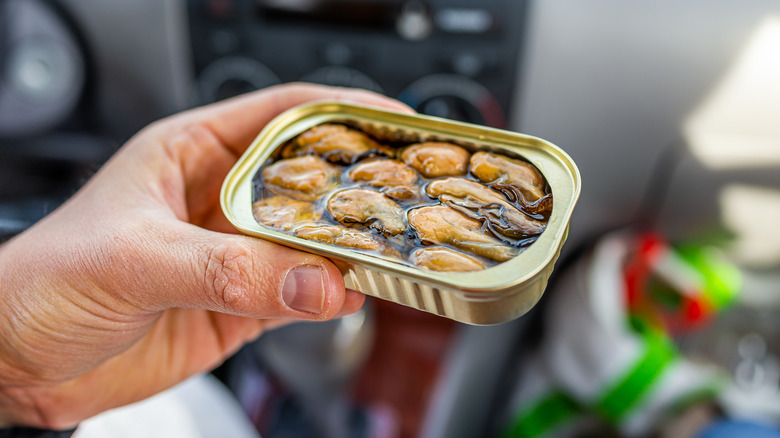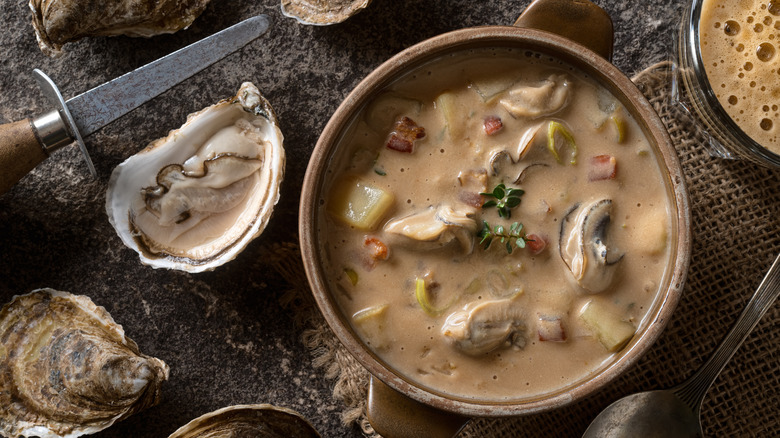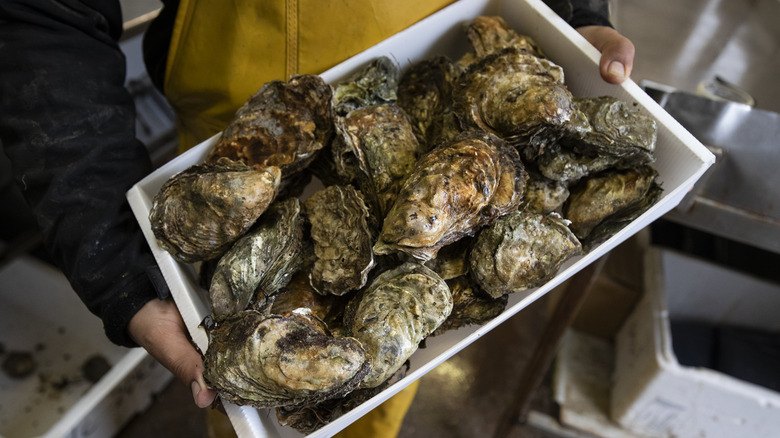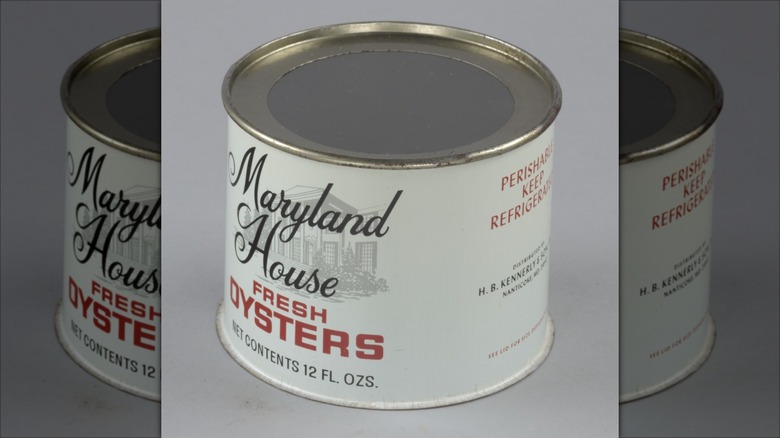The Canned Seafood You Should Use To Make Convenient, Cozy Soups This Fall
We may receive a commission on purchases made from links.
When it comes time to make your cozy fall soups, there is an ingredient that's both convenient and that complements the flavors of typical fall soup vegetables that fill so many soup recipes. This ingredient also adds briny and earthy umami undertones to your soup. And what is the wonder ingredient? Oysters. Fortunately, with an abundance of canned oysters in your pantry, you'll never have to worry about having to shuck 'em or worry if they're fresh. Just open a can and drop them into your creamy soup as it bubbles on the stove.
Oysters are members of the mollusk family known as "bivalves." They and their clammy cousins have earned this name from their two half shells that are bound together on their backs. They can be found in both fresh and salt water.
As for how they taste ... that's determined by where the oysters were caught. Their environment determines their flavor. While most oysters taste briny, bivalves that come from the West Coast boast an elegant and pleasant taste that hints of melon and cucumber. On the other hand, oysters fished from East Coast waters take on a more seaweed-like flavor. Of the two, East Coast oysters sport a smoother and larger set of shells than their West Coast counterparts do.
Oyster soup recipes to try
Most oyster fans know that there is such a thing as oyster stew. For a while, it was such a popular soup that it was even possible to buy oyster stew right off the shelves from Campbell's. No assembly required. Just open the can and enjoy your soup, oysters and all. And while Campbell's discontinued its soup, you certainly can use your canned oysters to make your own version of oyster stew. You basically just make a cream soup base and add canned oysters, including the juice, to the soup.
Seafood bisque or chowder presents additional options. If you'd like something chunky and hearty, then whip up a batch of oyster chowder. If you're going for a more refined flavor and texture, opt for a seafood bisque and fill it with not only oysters, but other types of seafood as well, like shrimp, crab, or clams.
Finally, if you're not a fan of creamy soups, you still have options when it comes to using oysters in soup. There is a variation of clam chowder that calls for both clams and oysters. The soup is typically creamy. However, non-creamy versions of clam chowder exist, like Manhattan clam chowder and Rhode Island clam chowder. In light of this, it might be worth experimenting a bit to make a clam chowder or oyster chowder mix from recipes like these to make an oyster soup without a creamy base.
How to make your oyster soup even better
Combining oysters from different parts of the world in one kettle of soup encourages more flavor complexity, due to the influence of each different kind of oyster. It's an East-Coast-versus-West-Coast kinda thing, though in this case, it's not a competition but rather a compliment to bring these two types of oysters together in the same soup.
However, there's more to leveling up your oyster soup than just mixing oyster types. You want to pay attention to the season, too. There is a saying in seafood circles: Only eat oysters that have been harvested during months with an "R" in their names. In other words, oysters have a season, and the season runs during the fall, winter, and early spring.
Spawning seasoning stretches from May to August. Anytime after that is a good time to eat oysters, though the longer they stay in the water, the more time they have to soak up the flavors of where they are. The colder the month that the oyster is harvested in, the more likely it is that the bivalve will be firm and lean in texture and bring a snappy umami brine flavor profile to the soup.
Additional tips to use canned oysters in soup
You can tell when and where the oysters were harvested by looking on the can. A "Best By" or "Use By" date, or something along those lines, typically appears somewhere on the box or can, usually the back. Those dates will give you a rough idea of when the oysters were harvested.
However, given that canned fish and seafood lasts several years, provided that the can isn't damaged, the dates on the can are really guides for taste. In other words, the closer you eat the oysters by their "Best By" dates, the better taste and texture experience you'll likely have. If there is a harvest date on the can, that's what you really want because you'll determine the month that the oysters came out of the water. And if it was a colder month, the tastier the oysters are likely to be.



